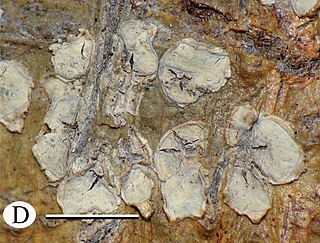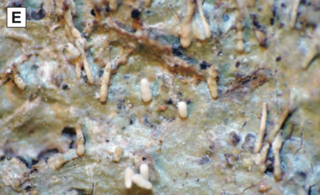
The Graphidaceae are a family of lichen-forming fungi in the order Graphidales. The family contains nearly a hundred genera and more than 2000 species. Although the family has a cosmopolitan distribution, most Graphidaceae species occur in tropical regions, and typically grow on bark.

Fissurina is a genus of lichenized fungi in the family Graphidaceae. It has about 160 species, most of which are found in tropical regions.

Diorygma is a genus of lichen-forming fungi in the family Graphidaceae. The genus was circumscribed by Franz Gerhard Eschweiler in 1824. Species of the genus are widely distributed in tropical and subtropical regions of the world.

Acanthothecis is a genus of lichen-forming fungi in the family Graphidaceae. The genus was circumscribed by Frederick Edward Clements in 1909.

Myriotrema is a genus of lichen-forming fungi in the family Graphidaceae.

Coenogonium is a genus of crustose lichens in the monotypic family Coenogoniaceae. It has about 90 species. Most species are leaf-dwelling or grow on bark, although a few are known to grow on rocks under certain conditions, and some are restricted to growth on termite nests. The genus was circumscribed in 1820 by German naturalist Christian Gottfried Ehrenberg.

Astrochapsa is a genus of lichen-forming fungi in the subfamily Graphidoideae of the family Graphidaceae. It has 28 species. The genus was circumscribed by Sittiporn Parnmen, Robert Lücking, and H. Thorsten Lumbsch in 2012, with Astrochapsa astroidea assigned as the type species. It was segregated from the genus Chapsa, from which it differs in having a more frequently densely corticate thallus, an apothecial margin that is mostly recurved, and the almost exclusively subdistoseptate, non-amyloid ascospores.
Wirthiotrema is a genus of lichen-forming fungi in the family Graphidaceae. The genus was circumscribed in 2010 by Eimy Rivas Plata, Klaus Kalb, Andreas Frisch, and H. Thorsten Lumbsch, with Wirthiotrema glaucopallens assigned as the type species. Wirthiotrema contains species that were formerly considered part of the Thelotrema glaucopallens species group. The genus name honours lichenologist Volkmar Wirth, "for his numerous outstanding contributions to lichenology".
Rhabdodiscus is a genus of script lichens in the family Graphidaceae. It has 36 species.
Henricus (Harrie) Johannes Maria Sipman is a Dutch lichenologist. He specialises in tropical and subtropical lichens, and has authored or co-authored more than 250 scientific publications. He was the curator of the lichen herbarium at the Berlin Botanical Garden and Botanical Museum from 1983 until his retirement in 2010.
Pseudochapsa is a genus of lichen-forming fungi in the family Graphidaceae. It has 19 species. It was circumscribed in 2012 by Sittiporn Parnmen, Robert Lücking, and Helge Thorsten Lumbsch, with Pseudochapsa dilatata as the type species. Pseudochapsa differs from Chapsa it that its excipulum is typically brown. Additionally, its ascospores are mostly discoseptate and amyloid. The generic name combines the Greek pseudo ("false") with the genus name Chapsa.
Graphidales is an order of lichen-forming fungi in the class Lecanoromycetes. It contains 6 families, about 81 genera and about 2,228 species. Family Graphidaceae are the largest crustose family within Graphidales order comprising more than 2000 species, which are widely distributed in tropical and subtropical regions of the world.
Clandestinotrema is a genus of lichen-forming fungi in the family Graphidaceae. It has 17 species. They typically inhabit montane and cloud forest at higher elevations in the tropics.
Gintarasia is a genus of lichen-forming fungi in the family Graphidaceae. It has seven species, all of which are found in Australia. Gintarasia species are corticolous (bark-dwelling), crustose lichens with a thelotremoid form.
Fissurina amyloidea is a little-known species of script lichen in the family Graphidaceae. It is found in the primary rainforests of Rondônia, Brazil. It is characterized by its weakly carbonizedlirellae and thick-walled, strongly amyloid ascospores. Despite its superficial similarity to Fissurina subfurfuracea, F. amyloidea exhibits unique anatomical features that set it apart from other species within the genus.

Acanthotrema alboisidiatum is a species of corticolous (bark-dwelling) crustose lichen in the family Graphidaceae. Described as a new species in 2014, it is primarily distinguished by its striking white isidia that contrast with its light olive-green thallus. The lichen was recognized as a new species despite the absence of ascomata and ascospores, usually crucial for taxonomic identification. Its DNA sequence data confirms its place in the Acanthotrema genus but distinguishes it from other known members of this genus. The species grows up to a diameter of 5 cm (2 in) and bears short, white isidiate outgrowths that resemble insect eggs. The lichen appears to favour the shaded understory of Tabonuco forests in El Yunque National Forest, Puerto Rico, particularly towards the base of Dacryodes excelsa trees.
Acanthotrema frischii is a species of corticolous (bark-dwelling) lichen in the family Graphidaceae. Found in the East Province|East Province of Cameroon, A. frischii has a smooth, olive-green thallus, and its broadly oval, glass-like ascospores. Although initially believed to represent Acanthotrema brasilianum, a Neotropical species, it was identified as a distinct species due to differences in ascospore structure.
Acanthotrema kalbii is a species of corticolous (bark-dwelling) lichen in the family Graphidaceae. First classified as a new species in 2012, the lichen is found in Costa Rica, where it grows in partially shaded areas of disturbed primary forest within the montane rainforest zone. This lichen stands out from its close relative, A. brasilianum, primarily due to the internal structure of its larger ascospores. The inaugural specimen of A. kalbii used for the species' formal description, was located on tree bark in a montane rainforest in the Las Tablas Protected Zone. The lichen is recognisable by its grey-green thallus, which varies from smooth to uneven and produces slender isidia, tiny outgrowths, up to 2 mm in length.
Compositrema is a genus of lichen-forming fungi in the family Graphidaceae. It has four species. The genus was circumscribed in 2012 by lichenologists Eimy Rivas Plata, Robert Lücking, and Helge Thorsten Lumbsch, with C. cerebriforme assigned as the type species. The genus is distinguished by its unique, composite pseudostromatic ascomata, which sets it apart from the otherwise similar genus Stegobolus.








